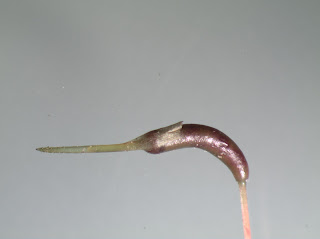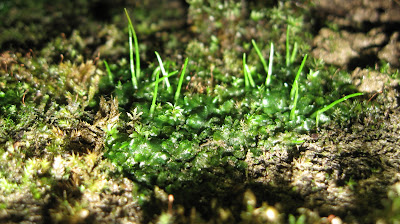 |
| Figure 3. Close up of Thuidium delicatulum |
 |
| Figure 2. Thuidium delicatulum seta and capsule with operculum. |
 |
| Figure 4. Peristome teeth of Thuidium delicatulum |
Name: Thuidium delicatulum The Delicate Fern Moss
Family: Thuidiaceae
Collection Date: Sept. 26, 2011
Habitat: Terrestrial moss found on rocks, soil, logs, stumps, and the bases of trees
Location: Hiram College Field Station woods
Description: Thick, yellow-green, fern-like, mesh-work of branched stems growing on the roots of a tree.
Collector: Jennifer Friedler
Key used: Conard, H.S. and P.L. Redfearn, Jr. 1979. How to Know the Mosses and Liverworts 2nd Edition, McGraw-Hill, Boston, Mass.
Keying Steps:
Introduction key pg. 19
1a. has stem and leaves; erect, ascending, prostrate, or hanging...2
2b. No hayline cells...3
3b. Green...pg. 28. Order Bryidae
Key to Families/Genera Bryidae pg. 28
1b. Green, one layer of cells...3
3b. Leaves in three or more rows...7
7b. No isodiometeric cells...8
8b. Leaves well developed and persistent...9
9b. Has a seta...10
10b. Distinct stem; has operculum...17
17b. Large plant...20
20b. Costa but no lamellae...28
28b. ….................................33
33b. ….................................139
139a. Papillose...140
140b. Papillae located over cell cavity...150
150b. Not fern-like erect or dendroid...152
152b. Leaves not oval...153
153b. One costa to the middle of leaves in some leaves...159
159b. Not complanate...160
160b. Capsule exserted beyond perichaetial leaves...161
161b. Papillae not forming single row over center of cells...163
163b. Small papillae; often more than one on a cell...164
164b. Paraphyllia numerous, filamentous, mostly branched...172
172b. Paraphyllia not attached to leaves...173
173a. Apical cell of branch leaves crowned with 2-4 papillae...pg 174 Thuidium
Key to Genera Thuidium pg 174
1b. large plants...4
4b stems 2-3 pinnate, spreading or curved-ascending...5
5b. stem leaves erect; no cilia on perichaetial leaves...6
6a. stem leaves not ending in a capillary point; perichaetial leaves ciliate...7
7a. stems regularly bi- or tripinnately branched; inner perichaectial ending in a hair point...Thuidium delicatulum
"Plants in robust green or yellow-green mats, stem 3-8cm spreading or arched-ascending, on soil humus, decaying wood, rocks or tree bases, in moist areas, Alaska to Labrador south to Arizona, in the east to the Gulf States." (Conrad 176).
Links:
http://www.ohio.edu/plantbio/vislab/moss/byrd.htm










